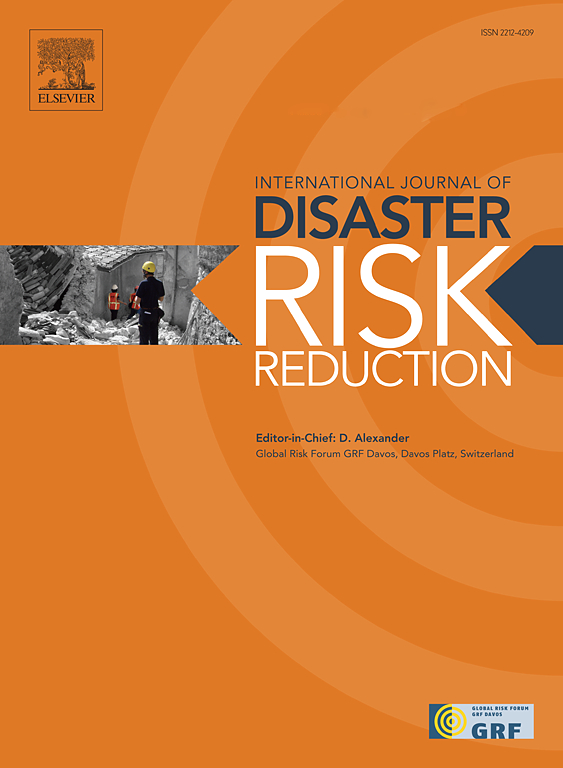Multifaceted economic impacts of a 500-year flood on gateway communities of Yellowstone National Park
IF 4.2
1区 地球科学
Q1 GEOSCIENCES, MULTIDISCIPLINARY
International journal of disaster risk reduction
Pub Date : 2024-09-19
DOI:10.1016/j.ijdrr.2024.104827
引用次数: 0
Abstract
Disasters can have dramatic implications for gateway communities of National Parks, especially local economies that rely on park tourist visitation as their primary source of income. In June 2022, a 500-year flood event impacted Yellowstone National Park (YNP) and gateway businesses, both directly through infrastructure damages (property loss) and indirectly through park closures and post-disaster marketing. We used a combination of approaches to document and explore the relative importance of these diverse sources of economic impacts. First, structured surveys were used to evaluate economic impacts, from the perspective of individual business owners and community leaders in six gateway communities surrounding YNP. Average revenue loss was 48 % during peak tourist season across all communities but averaged 75 % for communities inaccessible to the park. Direct infrastructure damages to businesses were localized; however, even businesses sustaining property losses suggested more severe economic impacts were the result of loss of visitors from park closures and damaging media coverage. Using annual visitation and economic input-output model data, we developed a statistical model to estimate regional economic impacts from the flood. The model corroborated the results of our survey and suggested the flood led to a total loss of $156 million in visitor spending in gateway areas in 2022, exceeding economic losses from the COVID-19 pandemic in 2020. We present some guidelines for building economic resilience in gateway communities, including diversifying sources of income, building social capital, embracing tourist adaptations, and developing coordinated park-gateway-regional messaging and marketing to the media post-disasters.
500 年一遇洪水对黄石国家公园门户社区的多方面经济影响
灾难可能会对国家公园的门户社区产生巨大影响,尤其是那些依赖公园游客作为主要收入来源的地方经济。2022 年 6 月,一场 500 年一遇的洪水对黄石国家公园 (YNP) 和门户商业造成了影响,直接影响是基础设施损坏(财产损失),间接影响是公园关闭和灾后营销。我们采用了多种方法来记录和探索这些不同经济影响来源的相对重要性。首先,我们通过结构化调查,从云南国家公园周边六个门户社区的个体工商户和社区领袖的角度评估了经济影响。在旅游旺季,所有社区的平均收入损失为 48%,但在无法进入公园的社区,平均收入损失为 75%。对企业造成的直接基础设施损失是局部性的;然而,即使是遭受财产损失的企业也表示,更严重的经济影响是公园关闭和破坏性媒体报道造成的游客损失。利用年度游客量和经济投入产出模型数据,我们开发了一个统计模型来估算洪水对地区经济的影响。该模型证实了我们的调查结果,并表明洪水导致 2022 年门户地区游客消费总损失达 1.56 亿美元,超过了 2020 年 COVID-19 大流行造成的经济损失。我们提出了在门户社区建立经济恢复能力的一些指导原则,包括收入来源多样化、建立社会资本、接纳游客的适应性以及在灾后向媒体发布公园-门户-区域协调的信息和营销。
本文章由计算机程序翻译,如有差异,请以英文原文为准。
求助全文
约1分钟内获得全文
求助全文
来源期刊

International journal of disaster risk reduction
GEOSCIENCES, MULTIDISCIPLINARYMETEOROLOGY-METEOROLOGY & ATMOSPHERIC SCIENCES
CiteScore
8.70
自引率
18.00%
发文量
688
审稿时长
79 days
期刊介绍:
The International Journal of Disaster Risk Reduction (IJDRR) is the journal for researchers, policymakers and practitioners across diverse disciplines: earth sciences and their implications; environmental sciences; engineering; urban studies; geography; and the social sciences. IJDRR publishes fundamental and applied research, critical reviews, policy papers and case studies with a particular focus on multi-disciplinary research that aims to reduce the impact of natural, technological, social and intentional disasters. IJDRR stimulates exchange of ideas and knowledge transfer on disaster research, mitigation, adaptation, prevention and risk reduction at all geographical scales: local, national and international.
Key topics:-
-multifaceted disaster and cascading disasters
-the development of disaster risk reduction strategies and techniques
-discussion and development of effective warning and educational systems for risk management at all levels
-disasters associated with climate change
-vulnerability analysis and vulnerability trends
-emerging risks
-resilience against disasters.
The journal particularly encourages papers that approach risk from a multi-disciplinary perspective.
 求助内容:
求助内容: 应助结果提醒方式:
应助结果提醒方式:


